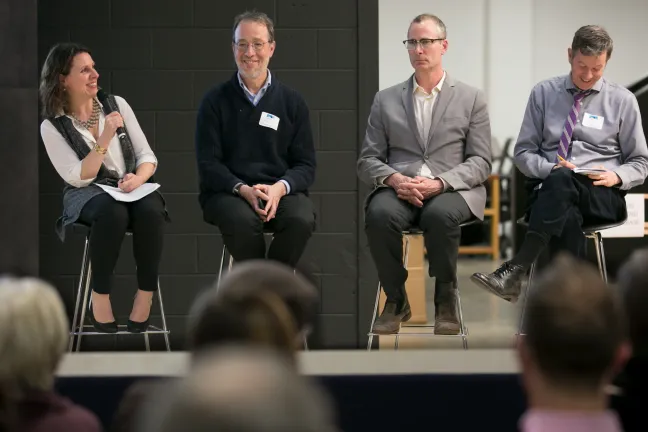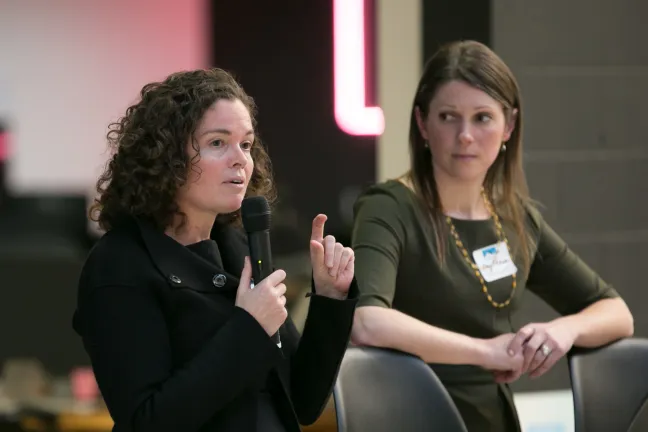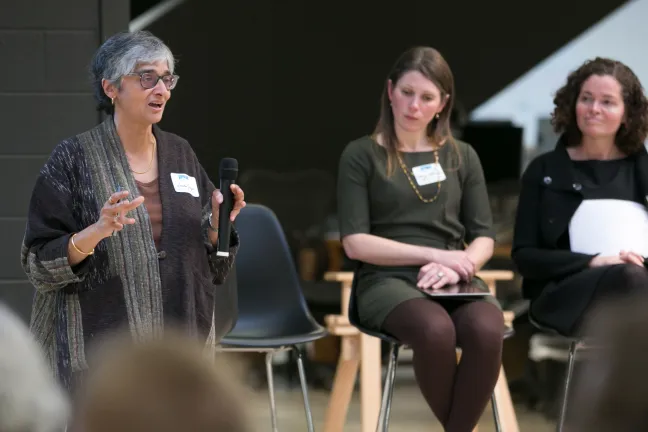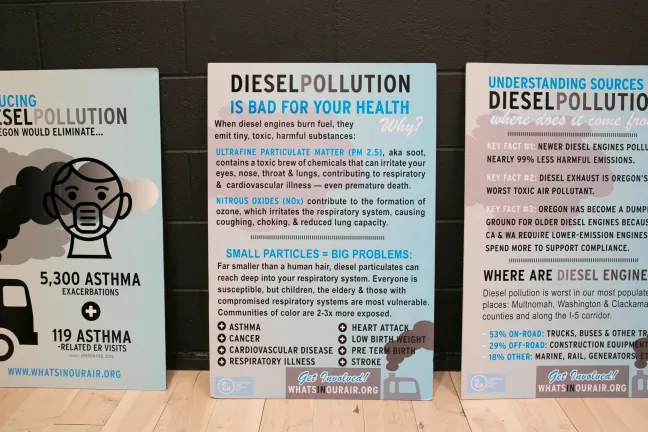More than a decade has passed since the Oregon Department of Environmental Quality published startling air quality models showing diesel pollution so dense it exposed every Multnomah County resident to an increased risk of cancer.
Six years have passed since the World Health Organization declared diesel pollution a known carcinogen, 100 times more toxic than gasoline exhaust, with particles so fine they slip through the lungs and into the bloodstream and brain, and so unsparing that 92 percent of Oregonians live in a neighborhood where their ambient exposure to the particulate puts them at an increased risk of developing lung and bladder cancer.
State lawmakers have since tried, and failed, to pass legislation that would reduce diesel emissions from Oregon industries and protect the state from becoming a dumping ground for old diesel trucks phased out of California. Inaction in Salem has frustrated local governments including Multnomah County, which has considered establishing a local air authority to limit emissions if the state does not.
But last week, a legal team from the Green Energy Institute at Lewis & Clark Law School proposed other ways state agencies and local governments can restrict diesel emissions without the blessing of state legislature or Congress. These include phasing out old diesel engines from government fleets, hiring contractors who use newer diesel equipment and controlling the roads through which trucks can pass, and the hours they can operate.
Multnomah County has already taken some of those steps, Chair Deborah Kafoury told those gathered for the presentation on Deconstructing Diesel, hosted by the Green Energy Institute and Neighbors for Clean Air.
The county has phased out older diesel vehicles, updated area school buses and helped contract construction firms upgrade older diesel equipment. She said she’s also working with other local governments to establish regional contracting standards.
“We know the legislature has a hard time getting things passed; we’re no stranger to stepping up and picking up the slack,” she said. “Our first priority would be to have high standards at the state level, but we also know Multnomah County has the dirtiest air in the state.”
Kafoury was joined by Metro Councilor Sam Chase, Rep. Rob Nosse and Sen. Michael Dembrow. Dembrow has teamed up with the county, Metro and the City of Portland in the past to propose legislative changes.
“I’ve been working on this for several sessions,” Dembrow said. “It was a real challenge. Getting anything done at the state level on an issue like this is hard.”
The Green Energy Institute, with a grant from the Bullitt Foundation, researched regulatory work-arounds for state agencies and local governments stymied by the legislative process. Federal law allows state and local governments to:
- Require commercial fleets to reduce aggregate emissions and phase out old diesel engines.
- Disallow the installation of old diesel engines in new truck bodies (known as “glider” trucks).
- Reduce the allowable time that trucks can idle.
- Establish mandatory truck routes and the times of day trucks can travel on those routes.
- Adopt California emission standards for new diesel vehicles.
- Require emission testing for heavy-duty diesel vehicles
“We should be willing to protect our own public health and stop those engines from entering our state,” said Institute Director Melissa Powers. “I think we should step up a bit in terms of regulation.”
“Toxic mini cannonballs’’
Diesel particulate is made up of dozens of chemicals, the bulk of which is black carbon, the soot so often associated with pollution. It is dangerous in part because the particles are so small — about one-400th the diameter of a human hair.
“HVAC systems don’t protect us from particles this small. Your basic furnace filter doesn’t protect you. Being inside doesn’t protect you,” said Portland State University researcher Dr. Linda George, who has measured levels of diesel particulate on Portland streets and in her own laboratory. “These are toxic mini cannonballs that enter our bodies.”
The Environmental Protection Agency regulates six air pollutants under the Clean Air Act including ozone and lead. Diesel particulate matter — known as diesel PM 2.5 — is one of 188 other air pollutants the EPA has recognized but doesn’t cap.
George didn’t focus her attention on diesel emissions until 2006, when the state’s Department of Environmental Quality published a map of the metro area showing the entire region was exposed to concentrations of diesel particulate higher than what Oregon Health Authority toxicologists deemed safe. In vast swaths of the region, the concentrations were at rates 10 times higher or more.
“There was this perception that Portland’s air is clean. I wondered, ‘can it really be this bad?” George recalled asking.
The professor of environmental science and management would spend the next decade proving the DEQ’s models correct. Today, diesel accounts for as much as 90 percent of the Portland Metro region’s cancer risk due to air pollution.
“It would have been better to find out the DEQ was wrong, that they were overestimating the amount of particulate in the air,” George said. “It’s terrifying to think we have that level of toxicity in the air. But our answer is, ‘yeah. It looks like those models are spot on.’”
Ahead of the curve
Kevin Downing sat in the audience last Wednesday evening and watched George talk about carrying on his 17-year campaign to reduce diesel emissions.
Downing retired in December from the DEQ, where he ran the Oregon Clean Diesel Initiative. He agreed to stay on with the agency to complete a few grants and train his replacement, whom the DEQ has yet to hire. Downing doesn’t mind the work, because, he joked. “I don’t know how to hunt or play tennis.”
Downing launched the Oregon initiative in 2000, the year the EPA — adopted stricter fuel standards that would go into effect in 2007, forcing vehicle manufacturers to create cleaner-burning motors for some heavy-duty vehicles.
Although the EPA has never declared diesel a known carcinogen, in 1999, California did and established safe exposure limits of .003 micrograms per cubic meter. California also passed laws to phase out older diesel engines by 2023.
In Oregon, Downing and the DEQ organized a major summit, hosted by Edgefield Manor, to explore the health risk of exposure to diesel exhaust.
“We were ahead of the curve at that point,” Downing said after last week’s event. Six years later, as a way to codify the agency’s concerns, Downing published the first models of diesel particulate in the Portland Metro area, the region in the state with most commercial interstate and freight traffic.
The results startled him, even as they validated his efforts since 2000. “There’s a certain perversity of working in air quality, when bad news is good news,” he said. “You realize you have met this challenge, that this is something deserving of attention.”
The DEQ estimated a safe exposure limit on diesel exhaust of .1 micrograms per cubic meter. The limit was 30 times higher than California's, but still so far from the current measures that the Portland region would have to reduce diesel emissions by about 90 percent to reach even that benchmark.
“There’s another reason too,” Downing said, almost as an afterthought. Research shows that, after carbon dioxide, black carbon is the largest contributor to global warming.
“Carbon dioxide stays in air for 50 to 200 years. Black carbon has a lifetime in the order of weeks,” he said. “Any reduction we take will make more significant near-term improvements.”
The next year, in 2007, Downing’s initiative received $1 million from the state general fund. Then the housing market crashed.
“The whole economy went into recession. There was no other money for a few years, then there was some tax credits for a few years, then those were taken away,” he said. “It’s been a one-man-show for most of this time.”
In 2009, the DEQ assembled the Portland Air Toxics Solutions advisory committee with 29 members from Multnomah County and other local governments, from environmental advocacy groups, and industry representatives from the Western States Petroleum Association, the Oregon Metal Industry Council, and Intel.
After two years of deliberation, the group published a thick report that laid out the scientific evidence on diesel pollution and a catalogue of recommendations for how to reduce emissions to safe levels. To get there, the DEQ estimated that trucks and heavy machinery operating in the Portland metro area would have to reduce emissions by about 90 percent.
The report recommended, among other things, a fund to help companies transition to cleaner-burning diesel engines, education and outreach, “including building citizen and consumer demand for clean diesel”, updating public fleets with cleaner diesel engines and electric cars; and requiring cleaner-burning diesel fleets and equipment for publicly-funded projects, including franchised or contracted fleets and equipment.
Stepping Up
By the time the DEQ published its “Portland Air Toxics Solutions Committee Report and Recommendations,” in 2012, Multnomah County had already retrofitted its fleet of vehicles with newer diesel engines, using a grant from the EPA. And it had adopted a
In 2013, the County helped construction contractors
“We’ve nibbled around the edges and now we really need to go in hard,” Chair Kafoury said at the event last week. “I think I can speak for the our commissioners and say we have strong, loud voices and we’re willing to use our bully pulpit to speak out at the state legislature.”
The county is looking to state lawmakers to make more sweeping change, she said. In 2015 Sen. Dembrow joined with Rep. Mitch Greenlick and drafted legislation that would set statewide diesel emission limits by 2020.
Multnomah County‘s Environmental Health director Jae Douglas testified in support of the bill. “Multnomah County has the 4th highest exposure rate to diesel exhaust of all United States’ counties,” she wrote in prepared remarks.
The EPA had quantified the cost of diesel exposure on Oregonians, and she laid out the numbers: diesel pollution in Oregon alone causes 460 premature deaths and 145 heart attacks every year. Workers miss 25,910 hours on the job. The failure to act was costing the state and its people more than $3 billion a year; and people of color and low-income people were picking up an unfair portion of the bill.
“The state has pledged to use environmental justice considerations in future strategies to reduce emissions from diesel,” she wrote. “We urge the state to fulfill that promise through the adoption of this bill.”
The bill never made it out of the House Committee On Energy and Environment. County leaders pushed for diesel legislation in 2016, 2017 and 2018, but nothing passed. Debrow said Oregon doesn’t have any money to help companies upgrade their fleets, unlike California and Washington, which tax portions of the vehicles, registration or hazardous waste. Oregon’s constitution doesn’t allow vehicle-related taxes be used for anything but road construction or maintenance. And that has stalled any push for regulation.
Last year, Oregon received $73 million as part of a sweeping settlement with Volkswagen, which manufactured diesel cars intended to defeat emissions tests. Lawmakers budgeted $28 million to retrofit school buses across the state, and are deciding now how to spend the remaining $45 million. Dembrow and leaders at Multnomah County have advocated for using the funds to help minority- and women-owned small businesses to upgrade their diesel engines.
“It is really easier to put these regulations on industry when you can help them make a transition,” he said last week.
The DEQ’s clean diesel initiative was originally intended to offer technical advice and commercial incentives to get companies to voluntarily move to cleaner-burning engines. But without incentives or new regulations, the agency had little impact.
“There’s no business case for doing this work,” Downing said. “These engines are durable, almost bulletproof.”
The newer engines might burn cleaner, but they don’t significantly improve gas mileage. And they run forever. In the 1980s, when a tugboat operating in the Portland harbor needed a new engine, it got one from a WWII submarine and ran for the next 20 years.
“Fundamentally, in my conversations with fleet owners, they need a strong signal towards change,” Downing said. “The state needs to give a signal of some form that things need to change, whether it comes in the form of regulation or a market signal. They need a signal sent to owners of these engines that … waiting for the last engine to die is not acceptable.”
Learn More
Read the 700-page report by the International Agency for the Research of Cancer
Read the miners study, published in 2012 after years of pushback from industry
Read the DEQ’s 2015 report on Concerns about Diesel Exhaust





